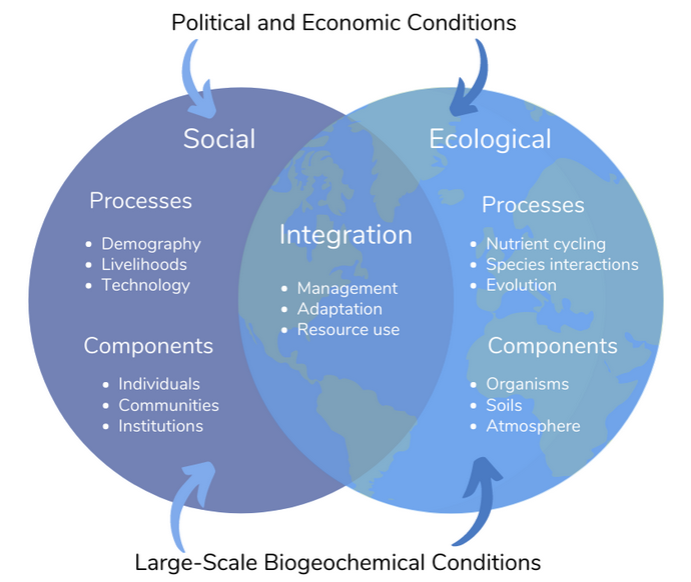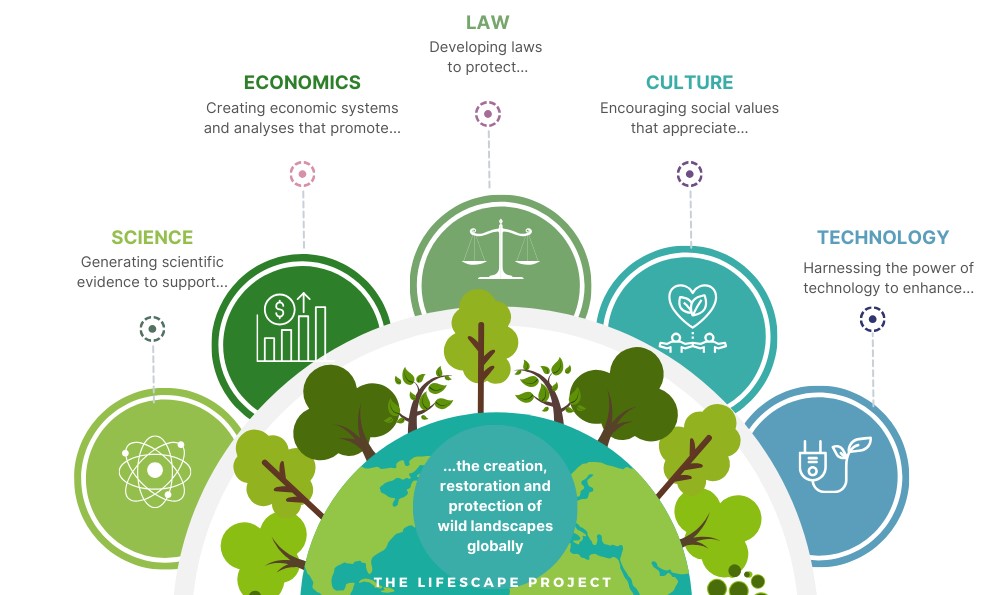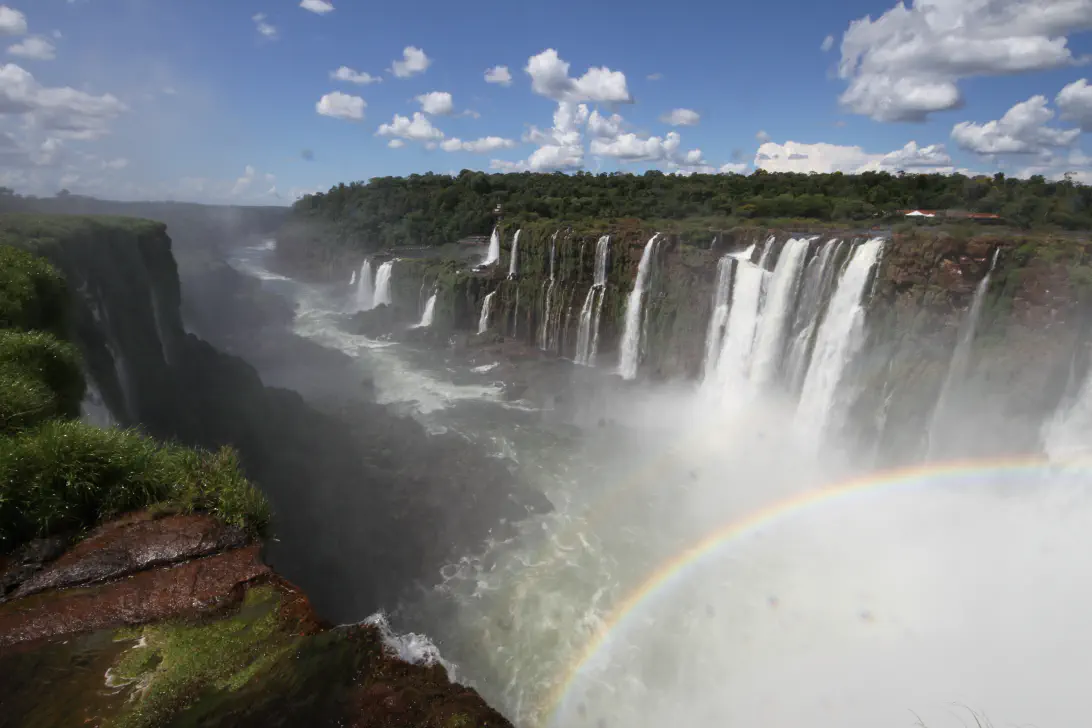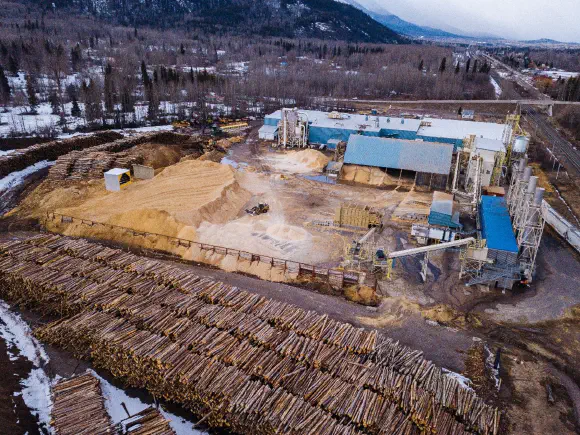At The Lifescape Project, our vision is to live in a world rich in wild landscapes, providing a sustainable future for life on earth. We’re on a mission to achieve this by catalysing the creation, restoration and protection of wild landscapes; by pursuing projects which use expertise across science, technology, law, economics, and communications.
How do these skills help achieve our mission, and how does collaborating in multidisciplinary teams make us more effective? This blog post is the first in a series explaining how we work, how we use different skills, and most importantly – how we collaborate and combine these skills to tackle the complex challenge of the biodiversity crisis. It will be followed by three posts demonstrating how we do that in practice, with examples from our current projects.
The other posts in this series can be found here once they go live:
Natural Capital Economics: Valuing Wild Landscapes
WildSide: Using Technology to Strengthen a Culture of Connection to Nature
The Forest Litigation Collaborative: Wielding The Law and Science for the Protection of Nature
A Sense of Urgency: The Biodiversity Crisis
At present we are facing a period of unprecedentedly rapid loss of biodiversity, often referred to as the biodiversity crisis. Scientific research even shows that our planet has now entered a sixth mass extinction.
Mass extinctions are characterised by extreme loss in species diversity within a short geological time period. Over the past 600 million years, there have been five mass extinction events. After each of these events, it took millions of years for biodiversity to recover.
Unlike past extinctions, the one we face today has been caused by a single species – humans – with many species unable to adapt and survive in an increasingly human-impacted world. Key drivers of this include overexploitation of the natural world, introduction of harmful invasive species, and pollution of land, air and water, as well as a changing climate.
This wave of extinctions has a cascading effect: each time a species, gene-pool or ecological community is lost the function of ecosystems is degraded, making them less resilient, and more susceptible to further extinctions.
If this mass extinction event continues it will have unprecedented detrimental effects on human well-being and society; its impact on us will be almost as profound as its impact on the natural world.
By protecting and restoring biodiverse wild landscapes, we work to counter the sixth mass extinction and the biodiversity crisis.
The Need for Multidisciplinary Solutions
“Our multidisciplinary model at Lifescape reflects the complexity of the crisis we hope to tackle. The five core areas we focus on encapsulate many of the key facets of human society which relate to, or impact upon, ecosystems.”
Adam Eagle, CEO of The Lifescape Project
A good example of why environmental issues often must be tackled from multiple perspectives at once, harnessing multiple disciplines, is the 1962 publication Silent Spring, by Rachel Carson. This was a book that revealed and publicised the dire effects DDT (a highly toxic pesticide) was having on insect populations in the USA and the impacts of this on the wider ecosystem, including human food supplies. The book is often heralded as being the first to inspire ecological activism among the US public. Despite the book’s irrefutable evidence which had been collected over many years, it took the US Government and Environmental Protection Agency a further ten years to ban the use of DDT, due to its economically useful applications in pest control and lobbying from the agro-chemical industry. Carson even held back on writing and publishing the piece for several years after beginning to collate the evidence it presented, as she knew she would be subjected to personal attacks from the industry whose interests the book would harm.
What this demonstrates is that scientific evidence alone is not necessarily enough to enact change in complex socio-economic systems. Evidence-based solutions will only bring about change if we acknowledge and respond to the political, economic, legal and social contexts in which they can be enacted. At Lifescape we are responding to this challenge as we pursue our mission.
Growing Knowledge of Ecosystem Complexity
As we have become increasingly aware of human impacts on the environment, we have also become increasingly aware of the complexity of ecological systems and the inter-dependence between different species which have coevolved over time. This has pushed a shift in the theory and practice of conservation biology away from single-species conservation and protected areas, to a more holistic landscape-scale approach which acknowledges what species and ecological processes need in order to function sustainably and to be resilient to change.
Expanding the scope of what ‘conservation’ means has also made it imperative to include people within the process of conservation and restoration, as people form part of almost any landscape: today ecological systems very rarely exist without humans or some form of human influence.
Recognition of the interactions within and between complex systems led to the development of the social-ecological systems model in the 1970s. This model – and a systems-thinking approach more generally – underpins our theory of change.

The socio-ecological system. Adapted from Virapongse, A., Brooks, S. Metcalf, E. C., Zedalis, M., Gosz, J., Kliskey, A. and Alessa, L. (2016) ‘A social-ecological systems approach for environmental management’, Journal of environmental management. England: Elsevier Ltd, 178, pp. 83–91.
Our Five Disciplines
At Lifescape, we embrace the need for solutions that properly consider nature, people, and the complexities of social-ecological systems. Taking this approach enables us to strengthen our understanding of how wild landscapes enable us all to thrive, and to ultimately bridge the growing disconnect between humans and nature.
By employing a range of skilled staff and volunteers from different fields and by collaborating with other organisations, we’re perfectly positioned to work on interdisciplinary projects which contribute to healthy and functioning wild landscapes.
Our core disciplines can be divided into five focus areas, although of course in reality these areas overlap in scope and are never entirely distinct from each other. Taking this multi-skilled, multidisciplinary approach helps to ensure we are designing projects and tackling problems from all relevant angles.

Our multidisciplinary approach. Visit our What We Do page to learn more about our projects.
The table below illustrates how the projects we work on take a approach spanning multiple disciplines, to help tackle the biodiversity crisis. Four projects are listed and examples are given of the disciplines engaged by each - each of these is the subject of a further blog post.
Our five core skill areas and how they contribute to the delivery of four project examples
| | Wildside | Forest Litigation Collaborative | The Natural Capital Laboratory | Eurasian Lynx Reintroduction Feasibility |
|---|
| Scientific | | Using forest and climate science to build arguments to protect forests | Collecting evidence to show the value of rewilding | ecological feasibility studies |
|---|
| Culture | Encouraging a culture which values wild landscapes and species | Using press coverage of our cases to build opposition to forest destruction | Developing innovative tools, e.g. using VR to communicate to people what it is like to experience wild landscapes | Undertaking public engagement and tackling the cultural phenomenon of the ‘shifting baseline syndrome’ |
|---|
| Law | | Enforcing existing laws to protect forests | | Considering the legal implications of a predator returning to our landscapes |
|---|
| Economic | Supporting local nature-based economies | Seeking to remove economic incentives for forest destruction | Using natural capital to account for environmental assets and services | Assessing the positive and negative economic impacts |
|---|
| Technology | Using our online platform and database to collect data | | Using new technologies such as drones, AI and remote sensing for surveying | Harnessing the newest software to conduct ecological modelling |
|---|
In 2017 The Lifescape Project developed out of a project which introduced a unique set of industries and individuals to one another. Those involved soon realised that they could combine their expertise in the fields of ecology, law, economics, science and technology and launch an independent charity, and we have continued in that spirit ever since. Follow this series of posts to find out how we’ve embraced the complexity of socio-ecological systems and applied our multidisciplinary experience to the fight for wild landscapes.






